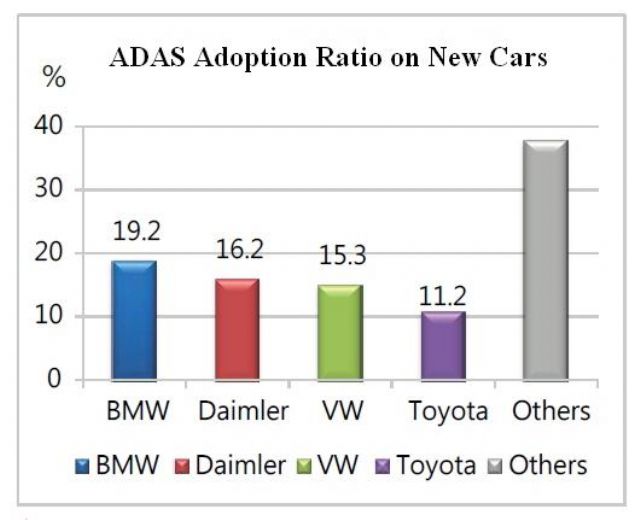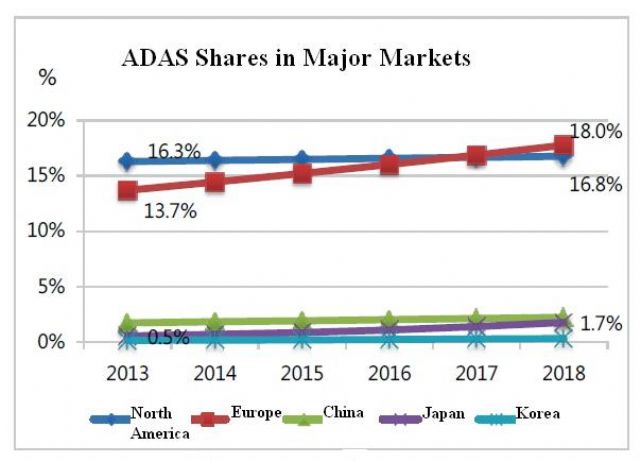ADAS Penetration Rate Expected to Keep Rising Globally: ARTC
2015/10/21 | By Quincy LiangAs many high-end equipment seen earlier only on luxury cars gradually become standard equipment on many makes and models, coupled with different nations' compulsory safety regulations or consumer preference, Advanced Driving Assistant System (ADAS) is becoming one of the most requested equipment among customers for their new cars all over the world, hence making ADAS one of the fastest-growing segments in automotive electronics.
ADAS are systems developed to automate, adapt, or/and enhance vehicle systems for safety and more efficient driving. Safety features are designed to avoid collisions and accidents by offering technologies that alert driver to potential problems and risks, or to avoid collisions by implementing safeguards and taking over control of the vehicle. Adaptive features may automate lighting, provide adaptive cruise control, automate braking, incorporate GPS/ traffic warnings, connect to smartphones, alert driver to other cars or dangers, keep driver in correct lane, or show what is in blind spots. There are many forms of ADAS available, with some features built into cars as standard equipment or are available as optional package. Also, there are aftermarket solutions available for some late model cars.
Basically, ADAS technology can be based upon vision/camera systems, sensor technology, car data networks, vehicle-to-vehicle (V2V), or vehicle-to-infrastructure (V2I) systems. The next-generation ADAS will increasingly tap wireless network connectivity to offer improved functionality and value by using car-to-car and car-to-infrastructure data.
Increasingly Popular
According to the Automotive Research & Testing Center (ARTC), a key transportation vehicle testing and R&D institute in Taiwan, three major German automakers, namely BMW, Daimler and Volkswagen (VW), together account for more than 50% of the world's ADAS market; while the world's largest automaker Toyota of Japan accounts for only 11% of the market. Such statistics show that currently ADAS are seen on medium-to-high-end car models only, but the penetration ratio is expected to continue rising in conjunction with the joint efforts by automakers and tier-1 parts suppliers.

Frost and Sullivan, an international automotive market research firm, forecasts that the prices for ADAS will slide by some 15% to 20% by 2018, when about 40% of new cars sold worldwide will be equipped with ADAS.
Europe & Japan
In 2013, global sales of ADAS reached some 124 million sets, generating revenue of US$14.76 billion, of which North America accounted for 17.6% and Europe 13.3%. Frost & Sullivan forecasts that global sales volume of ADAS is expected to top 355 million sets by 2018, with total revenue outstripping US$35 billion, representing compound annual growth rate (CAGR) of 19.2%.

Another region that is forecast to see explosive ADAS market growth is Europe, where international luxury-car makers and tier-1s cluster, Frost & Sullivan says. By 2017, the research firm predicts, ADAS sales in Europe are expected to account for 18% of the global overall, surpassing North America to be the world's largest ADAS market.
Japan is another high-potential market for ADAS. In 2013, about 530,000 sets of ADAS were sold in the country, representing a global share of only 0.5%; but Frost & Sullivan forecasts the annual sales volume will top some 6.15 million sets , an 11-fold growth, by 2018, as major Japanese tier-1s, such as Denso, Aisin, etc., aggressively catch up to launch newer and better products.




